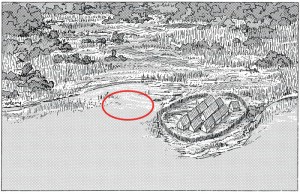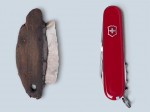 I love that headline. It seems such a bland, stolid find, so appropriately Swiss. It’s a pretty awesome door, though, seriously.
I love that headline. It seems such a bland, stolid find, so appropriately Swiss. It’s a pretty awesome door, though, seriously.
It was found in Zurich during preparatory excavations for a parking lot near the Opera House. Dendrochronological (ie, tree ring) analysis, dates the wood to 3,063 B.C. That makes it one of the earliest doors ever uncovered in Europe. An older one dating to 3,700 B.C. was found in a nearby town in the 19th century, but it was made from solid wood. This most recent door is a more complex, ingenious design.
The door measures approximately 5′ by 3′ and has been extremely well-preserved in the anaerobic environment of Lake Zurich sediment. You can still see how the planks were joined using a system of plugs, and the two simple wooden hinges that allowed the door to swing in its frame.
 The dig has uncovered a great many other artifacts from multiple Neolithic settlements on the shore of Lake Zurich.
The dig has uncovered a great many other artifacts from multiple Neolithic settlements on the shore of Lake Zurich.
Archaeologists have found traces of at least five Neolithic villages believed to have existed at the site between 3,700 and 2,500 years B.C., including objects such as a flint dagger from what is now Italy and an elaborate hunting bow.
Helmut Schlichtherle, an archaeologist for the conservation department in the German state of Baden-Wuerttemberg, said finding an intact door was very rare, as usually only the foundations of stilt houses are preserved because they are submerged in water for millennia. Without air, the bacteria and fungi that usually destroy wood in a matter of years can’t grow, meaning many lakes and moorlands in Europe are considered archaeological treasure troves.
“Some might say it’s only a door, but this is really a great find because it helps us better understand how people built their houses, and what technology they had,” he said.
Also, there have been hundreds of stilt house remains found in Germany, but no doors. Tiny Switzerland, on the other hand, has produced the 3 oldest ones known in Europe.
 The other seemingly-pedestrian finds will illuminate Neolithic life as well. The dagger from Italy, for instance, can provide information about Stone Age trade across the alps. The elaborate hunting bow has a bark design on it which has been attached by an unknown adhesive. There were also tinderboxes with fire-making tools still inside them, including F. fomentarius (aka, Tinder Fungus) mushrooms which Otzi the Iceman was also carrying when he met his end in the Tirolean Alps, not so far from Lake Zurich. Otzi lived 5300 years ago, so he and the door are almost contemporaries.
The other seemingly-pedestrian finds will illuminate Neolithic life as well. The dagger from Italy, for instance, can provide information about Stone Age trade across the alps. The elaborate hunting bow has a bark design on it which has been attached by an unknown adhesive. There were also tinderboxes with fire-making tools still inside them, including F. fomentarius (aka, Tinder Fungus) mushrooms which Otzi the Iceman was also carrying when he met his end in the Tirolean Alps, not so far from Lake Zurich. Otzi lived 5300 years ago, so he and the door are almost contemporaries.
The dig will continue until January, so who knows what else will turn up. There are more pictures of the Opera House dig and its Neolithic finds on the Zurich Structural Engineering Department website.